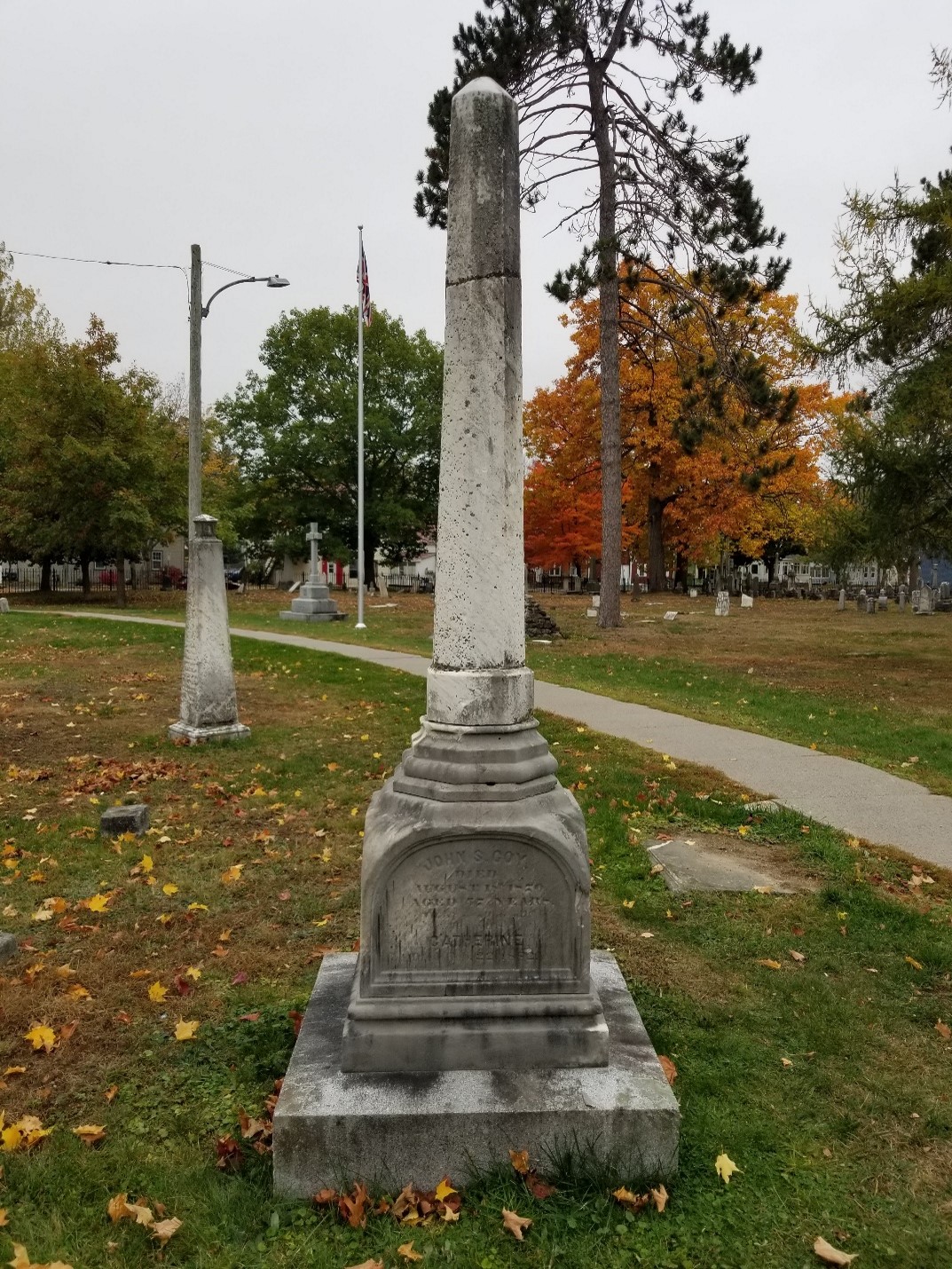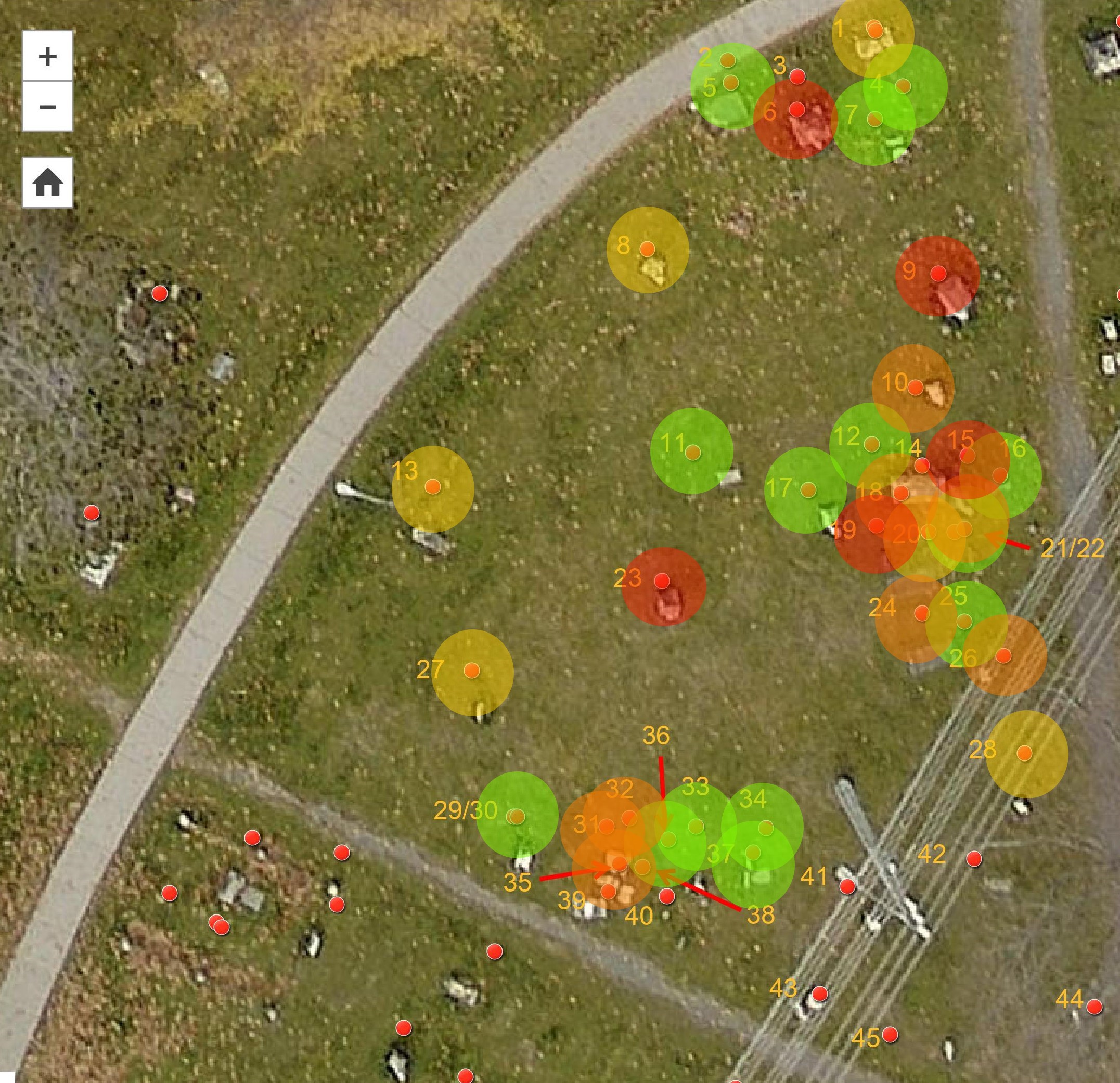- Submitted on
- 3 comments
The Old Burial Ground in Fredericton, New Brunswick were originally established in the years after fleets of Loyalist families arrived in the province in 1783. Loyalists erected numerous settlements across the provinces of New Brunswick and Nova Scotia, establishing the cities of Fredericton, Saint John, Digby, and Shelburne. Originally intended as a public square by surveyors, the grounds instead saw their first internment in 1787 with the burial of British Officer Anthony Foster, marking the founding of one of the city’s oldest cemetery.
Today, the cemetery is home to over two thousand burials, including a sizable section of once fenced-in family plots, an array of individual burials, and two monuments. The first of these monuments was dedicated to the “Founding Fathers” of the City of Fredericton and the Province of New Brunswick, and the second memorialized the British soldiers who served Fredericton from 1784 to 1869. The grounds remained fully open to new internments for just under a hundred years, at which point limits were enacted for future burials in 1886. The grounds’ final burials occurred in the mid-twentieth century.
When I first set foot in the cemetery last Fall, I was struck by how much variation existed between the different burial sites. On the one hand, many headstones were ornate and well preserved. Fine craftsmanship was bolstered by quality building materials, contributing to the construction of substantial memorials that towered as high as eight feet. On the other hand, many more graves looked like abandoned relics of a forgotten past, their inscribed names long since faded away. For the most part, the headstones at the Old Burial Ground sat as little more than novel-sized stone rectangles, toppled by natural forces or otherwise damaged.

I came away from the trip with a few questions bouncing around in my head. Most importantly, I wanted to know if there was any discernable relationship between the estimated “price” or value of a headstone and how they were grouped together. Did wealthy Loyalists want to be buried alone or with others? Were poor or middle-class Loyalists designated their own separate plots or were they buried next to the wealthy, regardless of class? I also wanted to know how many “low-income plots” there were compared to “high income plots”: was the Old Burial Ground mostly meant for upper class individuals, lower class individuals, or some combination of the two?
With these questions in mind, I set out to devise a feasible way to appraise the headstones at the Old Burial Ground. I decided to analyze the headstones using three metrics: size, intricacy, and length of inscription. I first measured “size” in inches cubed, using a flexible tape measurer to get an idea of just how big each headstone actually was. I followed up by judging “intricacy” based on how many unique design elements were incorporated into each headstone. These included but were not limited to the inclusion of carved borders, indents, baseplates, shapes like crosses, figures, and other geometric patterns. Finally, “length of inscription” was collected by counting each individual character carved onto the headstones. These included letters, numbers, dashes, commas, and all other forms of punctuation. Keep in mind, the data collection process was fairly informal and included some subjective analysis to decide what counted as a design element and whether or not a letter was too faded to be included in the length of inscription.
Still, when all was said and done, I walked away having collected the data of thirty-seven gravestones. I chose to investigate just a small section of the Burial Ground because of time constraints. Once all the data was analyzed, I scored each gravestone out of 12, with 1-4 being considered low-grade, 5-6 being considered moderately low grade, 7-8 being considered moderately high-grade, and 9-12 being considered high-grade. The data is printed in full below:
Table 1
|
|
Name |
Size (Cubic inches) |
Intricacy |
Length of Inscription |
Cost |
Grade |
|
1. |
Joseph Rosborough |
3243 |
2 |
42 |
5/12 |
Mod. Low |
|
4. |
NA |
112 |
0 |
2 |
3/12 |
Low |
|
5. |
NA |
3640 |
1 |
24 |
3/12 |
Low |
|
6. |
John Coy |
65664 |
7 |
236 |
12/12 |
High |
|
7. |
Martha M. |
1458 |
1 |
29 |
4/12 |
Low |
|
8. |
Charles Segee |
9680 |
2 |
0 |
5/12 |
Mod. Low |
|
9. |
Ann Francis |
117000 |
4 |
120 |
10/12 |
High |
|
10. |
John Woodward |
10659 |
4 |
56 |
8/12 |
Mod. High |
|
11. |
Charles Gilbert |
1020 |
0 |
50 |
4/12 |
Low |
|
12. |
NA |
130 |
0 |
20 |
3/12 |
Low |
|
13. |
David |
1530 |
1 |
105 |
5/12 |
Mod. Low |
|
15. |
James Drake |
70980 |
8 |
120 |
11/12 |
High |
|
16. |
Gary Winslow |
990 |
1 |
50 |
4/12 |
Low |
|
17. |
NA |
63 |
0 |
0 |
3/12 |
Low |
|
18. |
NA |
58500 |
5 |
0 |
7/12 |
Mod. High |
|
19. |
Margaret J. |
14872 |
3 |
85 |
9/12 |
High |
|
20. |
NA |
1920 |
1 |
70 |
5/12 |
Mod. Low |
|
21. |
NA |
302.5 |
0 |
3 |
3/12 |
Low |
|
22. |
NA |
3120 |
3 |
30 |
6/12 |
Mod. High |
|
23. |
James Edmond |
14504 |
10 |
240 |
11/12 |
High |
|
24. |
Martha |
8064 |
2 |
60 |
7/12 |
Mod. High |
|
25. |
NA |
392 |
0 |
0 |
3/12 |
Low |
|
26. |
NA |
9760 |
1 |
150 |
7/12 |
Mod. High |
|
27. |
NA |
2800 |
3 |
25 |
5/12 |
Mod. Low |
|
28. |
NA |
648 |
3 |
12 |
5/12 |
Mod. Low |
|
29. |
NA |
1480 |
1 |
0 |
3/12 |
Low |
|
31. |
NA |
1599 |
2 |
60 |
6/12 |
Mod. High |
|
32. |
Lorenzo Dunbar |
1440 |
4 |
70 |
7/12 |
Mod. High |
|
33. |
NA |
160 |
0 |
0 |
3/12 |
Low |
|
34. |
C. B. S. |
192 |
0 |
3 |
3/12 |
Low |
|
35. |
NA |
2016 |
3 |
35 |
6/12 |
Mod. High |
|
36. |
NA |
1920 |
2 |
0 |
4/12 |
Low |
|
37. |
John S. Moore |
600 |
0 |
35 |
4/12 |
Low |
I also made a “heatmap” to display the spread and groupings of headstones and their associated value.

As far as I could tell, it seemed like the few “high-grade” and “moderately high-grade” burials tended to belong to entrenched families already capable of setting up familial burial sites. These were mostly located on the center to East end of the site. The distribution of scores followed a fairly standard pattern, wherein high wealth was rare, moderately high and moderately low wealth was fairly common, and low wealth was very abundant. I located five high-grade graves, eight moderately high graves, six moderately low graves, and fourteen low graves. For reference, this means there were just as many moderate graves as low-grade graves. It did not seem like there was much of an effort to separate the burials of the wealthy from the burials of the poor, although there was a high concentration of low-grade burials in the site’s Southern region.
Eighteenth-century New Brunswick was a highly stratified society. The most fortunate Loyalists came from very wealthy backgrounds, with the affluent establishing themselves as prominent land, business, and slave owners in the province. The five high-grade burials most likely belong to these classes. Hordes of artisans and labourers also made their way to New Brunswick aboard the same boats, working in the city of Fredericton but without the same comforts as their upper class contemporaries. Alas, Fredericton was no stranger to the poor and destitute. Many did not have the money or experience necessary to find land and build suitable lodgings. The land they did receive was often remote and of abhorrently poor quality and size. Growing crops bordered on the impossible, with much of the labour expended on the plots going towards tidying rocky planes and fields. As one survey says, “much labour was expended on clearing the land and picking off the stones.”
These factors made the establishment of intergenerational wealth extremely difficult for the province’s Black and lower-class communities. The headstones used for low-grade burials were simple and extremely small slabs of stone, the smallest of which measured only sixty-three cubic inches. They lay as a stark reminder of Fredericton’s roots and the varied, determined lives that their owners once led.
Sources Used
Spray, William A. “The Settlement of the Black Refugees in New Brunswick 1815 - 1836.” Acadiensis, vol. 6, no. 2, 1977.
Harrison Dressler is in his fourth year in the fields of History and Political Science at the University of New Brunswick. He spent his Summer working as a researcher at AIDS New Brunswick.

Comments Add comment
Graves in Frederiction
Response from author
Hello Mr. Romanski and Ms. Prytula,
I'm afraid cemeteries are not my exact research focus. I would say further research needs to incorporate information on the materials used (types of stone etc.) to get a more accurate depiction of exact price. The lowest grade stones were all the same size and seemed to come from the same source. It would not surprise me if they were issued by the state for those who could not pay. Today, these things seem to be done provincially. I couldn't find much on NB, but in Ontario they have a clause that says that with "written instruction from a welfare administrator," individuals can be provided with lots and stones (most likely subsidized or free of charge). These things would shift according to the historical period, so I fear giving any exact answers would take more time than I have right now! I appreciate the comments and kind words.
Best,
Harrison
Graves in Fredericton
Add new comment Comments